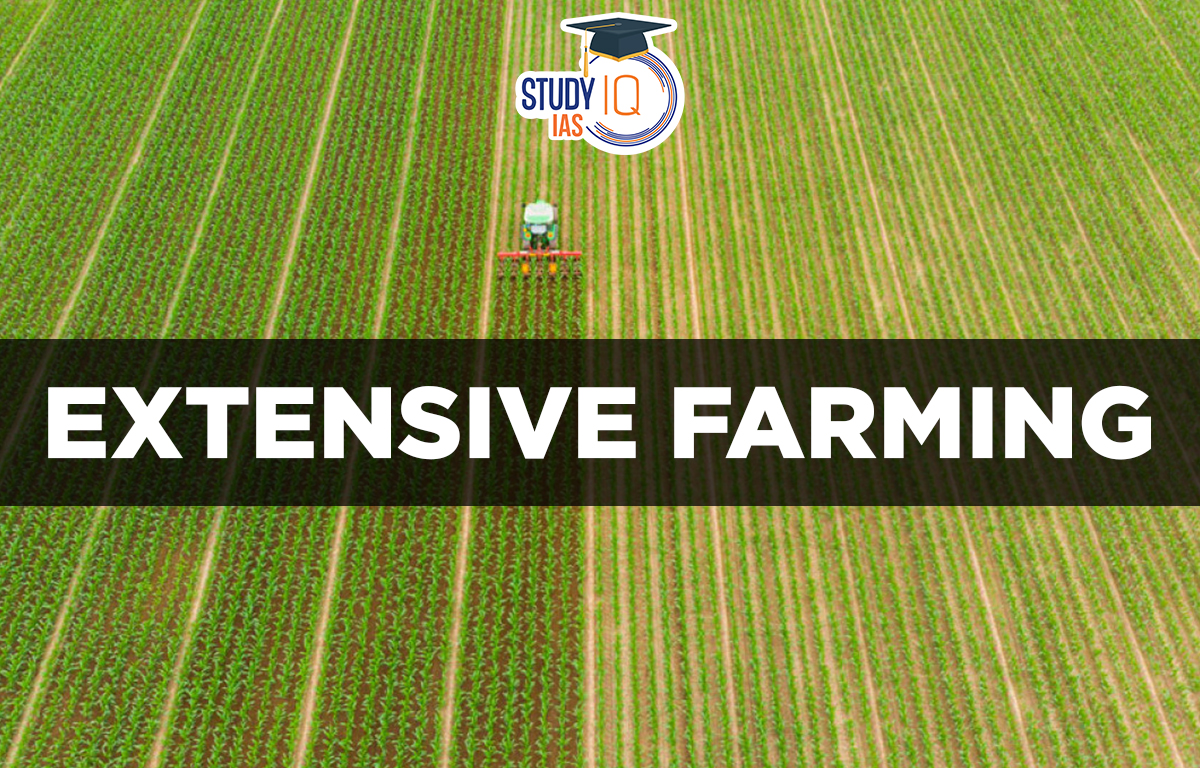Table of Contents
Extensive Farming
Extensive farming is a method that uses large machines, chemical fertilizers, and pesticides. It requires a lot of money and is done on large areas of land with few people. This type of farming is common in places like Argentina, Australia, parts of the USA, Canada, Ukraine, and Russia, where there is a lot of farmland and a low population. It uses less labor, fertilizer, and capital compared to the amount of land being farmed.
In agricultural economics, extensive agriculture is a method of crop production that consumes little labour and resources compared to the area being farmed.
Read More: Subsistence Farming
Extensive Farming Nature & Method of Cultivation
Extensive Farming is highly mechanized with machines. Machines are involved from ploughing to harvesting. This includes the work of ploughing, ground preparing, seeding, manuring, spraying insecticides, and even harvesting.
Read More: Natural Gas
Extensive Farming Examples of Crops Grown
In extensive farming, many crops are grown. The most popular crops grown on large-sized farmlands are:
- wheat,
- maize,
- millets,
- corn,
- cotton, and
- fodders for animal rearing.
Read More: Coastal Landforms
Extensive Farming Areas of Practice
Extensive farming is done in areas with large farmlands and low populations, where not all land can be cultivated. To overcome the lack of workers advanced machines and equipment are used. This type of farming is found in places like the Prairies in the USA and Canada, the Pampas in Argentina, the Veld in South Africa, the Downs in Australia, and the Steppes in Eurasia. It is mostly practiced in temperate grassland regions around the world.
Read More: Types of Soil in India
Extensive Farming Characteristics
Extensive farming is, characterized by the following features:
- Farmlands are extensive, covering hundreds of hectares.
- There are few people living in these areas, leading to a shortage of labor, so farming relies mainly on machines.
- Extensive farming is capital-intensive, needing skilled workers, chemical fertilizers, pesticides, and advanced agricultural machinery.
- High wages for agricultural labor are due to the limited supply of workers.
- Farmers choose crops that are best suited for the local environment.
- While the yield per hectare is low, the overall production per person is high.
- This type of farming is market-oriented, with crop selection influenced by market demand, sometimes even international markets.
Read More: Monsoon in India
Extensive Farming Advantages
- Total production in this farming is quite large hence farmers get handsome profits.
- Production cost is low; therefore, marginal profits are high.
Read More: Natural Vegetation of India
Extensive Farming Disadvantages
- Extensive farming is capital-intensive; therefore, initial capital investment is high.
- The dearth of skilled agricultural labour often poses a problem in these lands of low population density.
Read More: soils
Extensive Farming and Intensive Farming
Extensive farming and intensive farming are two different types of agricultural practices. The main differences between the two are in the level of inputs and the amount of land used.
| Extensive Farming | Intensive Farming |
|
|
Differences Between Extensive and Intensive Farming
Some important differences between extensive and intensive farming include:
- Land Use: Extensive farming uses a large area of land to produce relatively low yields, while intensive farming uses a smaller area of land to produce high yields.
- Input Use: Extensive farming involves minimal use of inputs, such as fertilizers and pesticides, while intensive farming involves high use of inputs to maximize yields.
- Labour: Extensive farming requires relatively little labour, while intensive farming requires more labour to manage the high inputs and production levels.
- Environmental Impact: Intensive farming practices can have a higher environmental impact due to the use of high inputs and the potential for pollution, while extensive farming practices often rely on natural resources and have a lower impact.
In summary, extensive and intensive farming are two different agricultural practices that vary in the amount of land and inputs used to produce crops or livestock. Both have advantages and disadvantages, and the choice of farming method depends on local conditions, resources, and goals.
Extensive Farming UPSC
The quantity of labour and capital inputs required to grow farms determines the difference between extensive farming and intensive farming. Compared to the quantity of land it uses, intensive farming requires a lot of labour and resources. Extensive farming, on the other hand, entails growing big farms with comparatively fewer labour and capital inputs.
Read More: Rainfall


 Role of Teachers in Educations, Student ...
Role of Teachers in Educations, Student ...
 India's achievements after 75 years of I...
India's achievements after 75 years of I...
 Bal Gangadhar Tilak Biography, Achieveme...
Bal Gangadhar Tilak Biography, Achieveme...

























